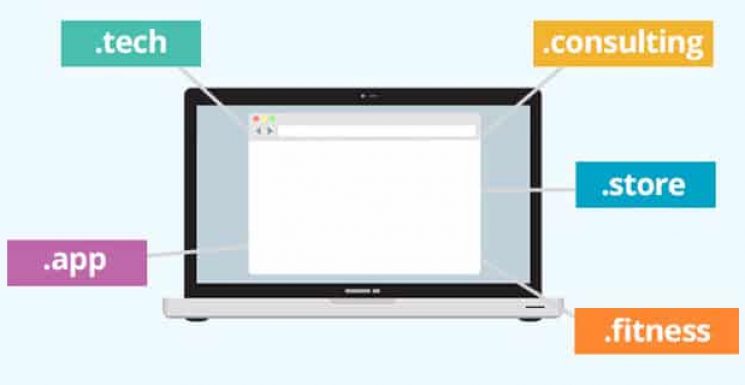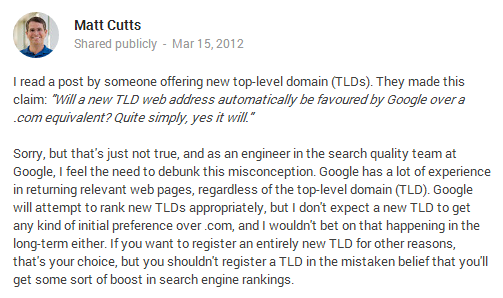In November 2013 the Internet Corporation for Assigned Names and Numbers (ICANN) started allowing companies to apply for new domains under a wide selection of new top-level domains (TLDs). For now, only trademark holders can register domains for protected words, but starting January 24, 2014, the first wave of these new TLDs will become publicly available and will include domains like .app, .computer, .lawyer and .store.
Name.com. There are undoubtedly marketers and businesses out there looking to make a land grab on January 24. The question is, should you?
What’s a TLD?
Without getting too technical, it’s the highest level of the Domain Name System. You’re probably familiar with the most common TLDs like .com, .org, .net, and .edu, and at least of some of the Country Code TLDs like .co.uk and .com.au.
Some of these were determined way back in the 1980s when the Internet was still in its infancy. Of course, the founders of the Internet had no idea that there would one day be billions of websites or that highly sought domain names would sell for outrageous sums of money.
Today, a good and affordable .com domain name can be hard to find. We’ve even seen the rise of misspelled company names partly because it’s cool but also because tumblr.com is cheaper than tumbler.com.
Releasing these new TLDs is supposed to help relieve some of the pressure behind the most popular generic TLDs and give webmasters some alternatives to choose from. To help you decide if buying a new domain is the right choice for you, we’re going to look at this from a couple of different perspectives.
Will a new TLD help my SEO?
In the past buying an exact-match domain (EMD), any domain that exactly matches the keyword you’re targeting (e.g., itsupportatlanta.com), was an easy way to get a boost in rankings. Today, not so much.
Google realized that EMDs and partially-matching domains were an easy way for spammers to gain a leg up, so last year they took some measures to decrease the inherent value of EMDs. However, this doesn’t mean that hosting your site on an EMD will hurt you. It just means that EMDs and non-EMDs are now on a more level playing field.
So how will Google treat these new top level domains? Well, Google’s head of web spam, Matt Cutts, has already come out and directly stated that a new TLD will NOT give you a boost in rankings.
With that said, there is still a way that EMDs and these new TLDs could still have an advantage over traditional domains. As Pete Myers points out, a cleverly worded domain on a new TLD could get more links with anchor text that contain targeted keywords.
For example, if you own https://sanfrancisco.accountant, people linking to you are more likely to link to you with text containing “San Francisco” and “account,” and this text is a factor that Google looks at when determining rankings.
Getting a lot of links with keyword anchor texts can be a sign to Google of spammy link building tactics, but in theory, if your domain is https://sanfrancisco.accountant then “San Francisco account” is part of your brand and all those keyword anchor texts were achieved naturally…in theory.
Speaking of branding…
Will a new TLD help my branding?
An often overlooked part of a good domain is its rememberability. Some domains like “amazon dot com” just roll off the tongue and are easy to remember while others like “cheap dash car dash insurance dash albuquerque dot net” don’t quite have the same ring.
A good domain should be easy to remember and should be directly associated with your brand or at least a service/product that you offer.
So will portland.architect be as memorable as its .com counterpart? It’s hard to answer that definitively right now. The current generic TLDs like .com and .org have been synonymous with the Web for the last couple of decades. They’ve become so ingrained in our dialect that they just seem natural while portland.architect seems cumbersome and incomplete.
But that doesn’t mean things will always be the way they are today. Years down the road, it’s possible that .coms will fall out of favor and we’ll be buying our stuff on amazon.store and looking for information on google.search.
So what should I do?
Well, if you already have a domain that you’re happy with, don’t do anything. The fear of missing out might be pushing you to just grab a bunch of domains, but unless you have a specific reason for moving to a new domain, don’t go jumping on these new TLDs.
Is it possible to build a successful website on a .fitness domain? Yes, absolutely, but like any domain, it will take a lot of work. A new TLD won’t be the magic bullet for your SEO struggles. In fact, new domains can take quite a bit more work than an already established domain.
Is it possible to build your brand around a .healthcare domain? For sure! But keep in mind that your new domain might seem a little awkward to people at first.
With that said, if you’re currently stuck with a domain like best-cafe-charleston.com, this might be an opportunity for you to grab a snazzy new domain like charleston.coffee.
Lastly, we occasionally get clients who buy 5-10 new domains and then redirect them to their primary domain. This is a misunderstanding of an old SEO tactic in which marketers bought high quality, pre-established domains (with lots of links) and redirected them to another site.
This technique is less effective than it used to be, and if you’re buying brand new domains on GoDaddy for $5, redirecting them to your main site does absolutely nothing. The same goes for brand new domains on these new TLDs. Buying 20 of them and redirecting them to your site will have ZERO impact on your SEO success.



